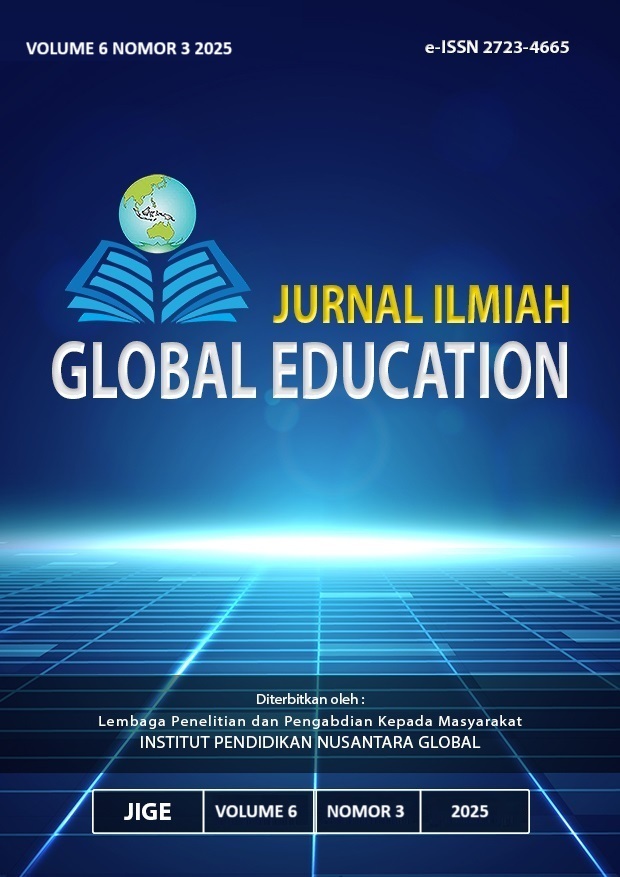Pendekatan Seni dan Budaya Islam (Islamic Art and Culture): Tinjauan Paradigmatif dan Implementatif dalam Pembelajaran PAI dan Budi Pekerti (PAI-BP)
DOI:
https://doi.org/10.55681/jige.v6i3.4169Keywords:
Arts and Culture, Islamic Religious Education, MoralsAbstract
Education is essentially a cultural process that has a significant influence on the survival of humans in carrying out religious, social, and cultural life. In this context, education and arts and culture are two entities that cannot be separated, because they interact and influence each other. Arts and culture have an important role in shaping the identity and personality of individuals and groups of people. Therefore, the ideal education process contains noble cultural wisdom values, in order to realize the development of students' characters holistically through cognitive, affective, and psychomotor aspects. Specifically, the main objective of Islamic Religious Education and Character Education (PAI-BP) is to shape the character and noble morals of students. Because PAI-BP is full of spiritual values and divine aesthetics, an arts and culture-based approach is considered relevant and effective. Through the integration of arts and culture, educators can design a more innovative, creative, and enjoyable learning process, because the learning contains elements of beauty that have educational value
Downloads
References
Abdul Majid (2012), Belajar dan Pembelajaran Pendidikan Agama Islam, Bandung: Remaja Rosdakarya.
Dian Nur Ana (2018), Seni dan Agama dalam Islam, Yogyakarta: Bildung.
Eka Titi Andrayani (2016), “Proses Terjadinya Suatu Karya Seni”, Jurnal Imaji Vol. 12 Nomor 2, ISSN 2580-0175.
Ensiklopedia Nasional Indonesia (1989), Jakarta: PT Cipta Adi Pustaka.
H.A.R Tilaar (2002), Pendidikan, Kebudayaan, dan Masyarakat Madani Indonesia. Bandung: Remaja Rosda Karya.
Heri Gunawan (2014), Pendidikan Islam, Kajian Teoritis dan Pemikiran Tokoh. Bandung: PT Remaja Rosdakarya.
John Felix (2012), “Pengertian Seni Sebagai Pengantar Kuliah Sejarah Seni Rupa”, Jurnal Humaniora Vol. 3 Nomor. 2, Oktober, 614-621.
Kartika, D. S (2004), Pengantar Estetika, Bandung : Rekayasa Sains.
Muhaimin dan Suti’ah (2002), Paradigma Pendidikan Islam; Upayamengefektifkan Pendidikan Agama Islam Di Sekolah, Bandung: Remaja Rosdakarya.
Nur Saidah, (2008), “Pendidikan Agama Islam dan Pengembangan Seni Budaya Islam”. Jurnal Pendidikan Agama Islam, Vol. V, Nomor. 1.
Oliver Leaman (2005), Estetika Islam, Manafsirkan Seni dan Keindahan, terjemah Irfan Abubakar, Islamic aesthetics, Bandung: Mizan.
Seyyed Hossein Nasr (1993), Spiritualitas dan Seni Islam, Bandung: Mizan.
Sindhunata (2000), Membuka Masa Depan Anak-anak Kita: Mencari Kurikulum Pendidikan Abad XXI. Yogyakarta: Kanisius.
Suhaya (2016), “Pendidikan Seni Sebagai Penunjang Kreatifitas”, Jurnal pendidikan dan Kajian Seni, Vol. 1 Nomor. 1, Apri, ISSN 2503-4626.
Yeni Rachmawati (2005), Musik Sebagai Pembentuk Budi Pekerti-Sebuah Panduan Untuk Pendidikan. Yogyakarta: Jalasutra.
Downloads
Published
How to Cite
Issue
Section
License
Copyright (c) 2025 Elya Susanti, Haris Riadi, Eti Susanti

This work is licensed under a Creative Commons Attribution-ShareAlike 4.0 International License.












